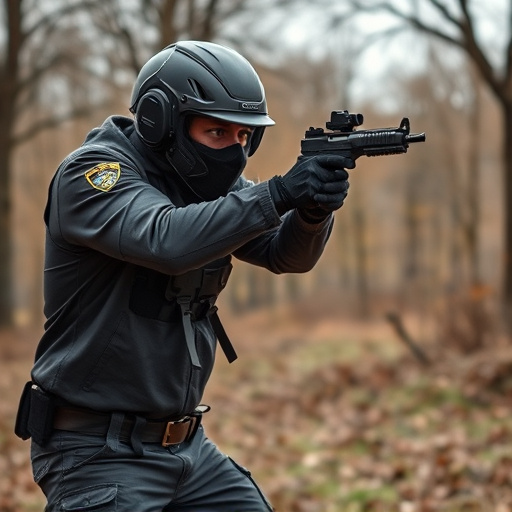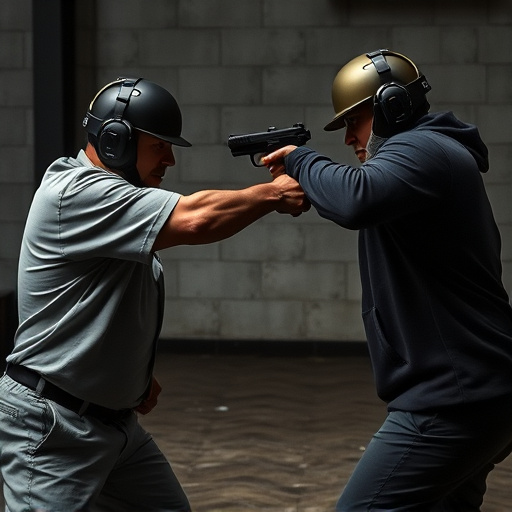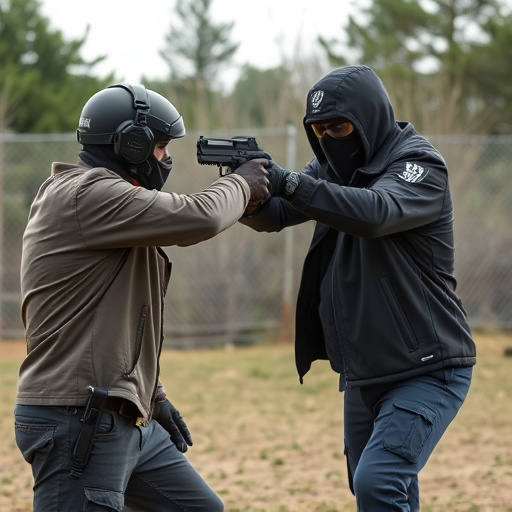Stun guns, non-lethal self-protection devices, temporarily incapacitate assailants through powerful electrical shocks that disrupt nerve signals, causing muscle spasms, disorientation, and paralysis. Effectiveness varies with voltage (50,000 – 100,000 volts recommended), target size/conductivity, and probe placement. Modern models incorporate safety features like LED lights, alarms, and auto-shutoff mechanisms. When selecting a stun gun, key specifications include electrical output, weight, size, activation mechanism, and battery life. Understanding the device's impact on the nervous system and adhering to local regulations are crucial for responsible use as a non-lethal defense option.
“Uncover the power of non-lethal self-protection devices, designed to ensure personal safety without causing permanent harm. This comprehensive guide explores the intricate world of stun guns and their remarkable impact on the nervous system. From understanding their mechanisms to deciphering crucial specifications, we delve into what makes these tools effective. We also navigate safety considerations and regulatory aspects, providing insights for informed decisions. By the end, readers will be equipped with knowledge to protect themselves confidently.”
- Understanding Non-Lethal Self-Protection Devices
- The Science Behind Stun Guns and Their Effects
- Key Specifications for Effective Self-Defense Tools
- Safety Considerations and Regulatory Aspects
Understanding Non-Lethal Self-Protection Devices

Non-lethal self-protection devices, such as stun guns, are designed to incapacitate an assailant temporarily without causing permanent harm or death. These tools operate by targeting the nervous system, disrupting its normal functioning through various means. The primary effect of a stun gun is to deliver a powerful electrical shock that can cause muscle spasms, disorientation, and temporary paralysis in the target. This disruption prevents the individual from continuing an attack, providing the user with precious time to escape or summon help.
Understanding how these devices work is crucial when considering their effectiveness as self-defense mechanisms. The stun gun effects on the nervous system are intended to be non-lethal and reversible. However, it’s important to note that the intensity of the shock and the duration of exposure can vary widely among models, impacting the level of disability caused. Proper training is essential for responsible use, ensuring individuals understand not only how to deploy the device but also when its application is appropriate and safe.
The Science Behind Stun Guns and Their Effects

Stun guns, also known as electronic control devices (ECDs), work by delivering a strong electric current through a metal probe into the target’s body. This sudden jolt disrupts the normal electrical signals sent to and from the brain, temporarily affecting the nervous system and muscles. The stun gun effects on the nervous system include temporary paralysis, disorientation, and loss of muscular control, enabling the user to escape or subdue an attacker.
The intensity and duration of these effects vary based on factors like the device’s voltage output, the size and conductivity of the target’s body, and the location of the probe. Modern stun guns are designed with safety features to prevent accidental discharge and minimize collateral damage. They often come equipped with LED lights, alarms, and auto-shutoff mechanisms to ensure their effectiveness while preserving the user’s well-being.
Key Specifications for Effective Self-Defense Tools

When considering non-lethal self-protection devices, understanding key specifications is crucial for ensuring their effectiveness in real-world scenarios. One paramount feature to look out for is the stun gun’s electrical output. The intensity of a stun gun’s electric current directly impacts its effects on the nervous system, rendering the target incapacitated temporarily without causing permanent harm. Devices delivering 50,000 to 100,000 volts are commonly recommended for optimal stun effectiveness, ensuring an individual can escape from potential threats safely.
Additionally, the weight and size of self-defense tools play a significant role in their practicality. Lightweight and compact devices offer better maneuverability, allowing users to carry them discreetly. This is especially important for personal safety as it enables individuals to have their stun gun readily available when needed. Moreover, features like easy activation mechanisms and long battery life are essential for quick response times during potentially dangerous encounters.
Safety Considerations and Regulatory Aspects

When considering non-lethal self-protection devices, such as stun guns, safety considerations are paramount. These tools are designed to incapacitate an attacker temporarily through targeted nerve disruption rather than causing permanent harm. However, understanding their effects on the nervous system is crucial. Stun guns deliver an electric shock that overloads the body’s electrical signals, leading to muscle spasms, disorientation, and temporary paralysis. The intensity and duration of these effects can vary based on factors like the device’s voltage output, contact points, and individual sensitivity.
Regulatory aspects also play a significant role in the development, distribution, and use of non-lethal self-protection devices. Many countries have strict guidelines regarding stun guns’ power levels, legal ownership, and permissible uses. Compliance with these regulations is essential to ensure public safety and prevent misuse. Manufacturers must adhere to specific standards for device performance, safety mechanisms, labeling, and packaging to gain market approval. Additionally, end-users need to be educated on the responsible use of such devices, including awareness of local laws and potential side effects, to maximize their effectiveness as a non-lethal self-defense option.
Non-lethal self-protection devices, such as stun guns, offer a powerful tool for personal safety without causing permanent harm. By understanding their science and effects on the nervous system (stun gun effects on nervous system), users can make informed decisions about self-defense. Key specifications like voltage, current, and energy output play a crucial role in ensuring effectiveness. Safety considerations and regulatory aspects must be taken into account to promote responsible use. With proper knowledge and precautions, these devices can empower individuals to protect themselves in various situations.
